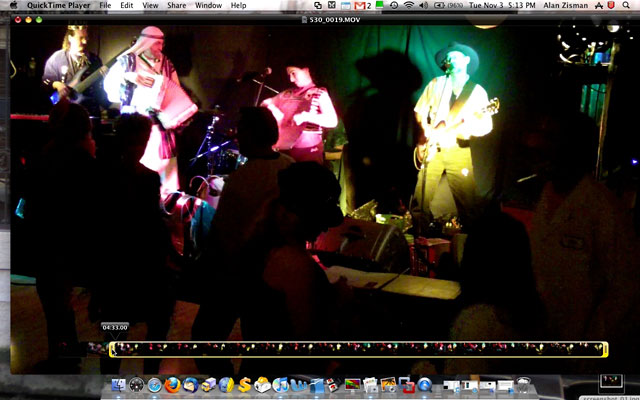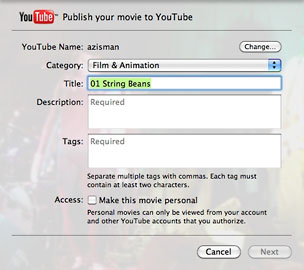 |
| About Alan |
| Tutorials |
| Free files |
| Win9x FAQs |
| E-mail Alan |
| |
| Articles |
| BIV articles |
| Archive |
| Other articles |
| Archive |
| |
 |
|
|
|
QuickTime
X in Snow Leopard Imports, Trims, and Publishes Video Quickly and Easily
by Alan Zisman (c) 2009 First published in Low End Mac November 4 2009 ZisMac column "Snow Leopard" (Mac OS X 10.6) has been, to a large extent, marketed by Apple with a lowering of expectations - instead of banners proclaiming "hundreds of new features", it's promoted more as a a clean-up/speed-up of OS X 10.5 "Leopard", offering better performance while taking up less hard drive space - but only for owners of Intel Macs. Along with the modest expectations, Snow Leopard comes at a modest price - US$29 for a single-user upgrade edition, compared to US$129 for most other OS X versions. But along with tightening the code and removing PowerPC code, Apple has quietly upgraded some Snow Leopard features. In Preview in Snow Leopard Supports Scanners and Screen Shots, I looked at few handy new capabilities of Snow Leopard's Preview app. Snow Leopard's version of Apple's long-time QuickTime player has also evolved. Now named QuickTime X, it gets a new icon and a new look. Apple calls it "a major leap forward" that will give users "enhanced playback, greater efficiency, and higher quality". Being built on various core OS X technologies, Apple suggests the new version will launch up to 2.4 times faster than its Leopard predecessor. QuickTime X also gained several features that Apple previously kept out of the free QuickTime viewer, reserving them for its $29 QuickTime Pro upgrade version (coincidentally, the same price as the single user Snow Leopard upgrade). You can now make an audio, video, or screen recording using your Mac's built-in hardware right from the QuickTime File menu using the iSight camera built-into many Mac models, for instance. More useful to me is the new ability to trim movies. I play in a couple of bands, and I've posted video clips of performances onto YouTube. I may video a set of 8 to 10 songs using a Creative Vado (see Creative's Vado Pocket Camcorders Now Work with Macs), Flip Mino, or Kodak Zi8 pocket camcorder. Recording the video is pretty straightforward. Up until QuickTime X, though, the next steps have been time consuming. Using iMovie, for instance, the first step is to import the hour or so of video into the program. iMovie then analyses the file, breaking it up into seemingly hundreds of individual scenes - and this takes quite a while. Then I have to locate the beginning and end of a song, selecting it out from the larger file. After I've done that, I might add titles, fade in and out, and the beginning and end - a fairly straightforward and quick process. But then, to create a video clip of just that single song, iMovie needs to render the video. On my MacBook, it may take half-an-hour or so to render a 5 minute video clip, giving me a file I can (finally) upload to YouTube. While I don't need to be sitting at the keyboard for much of the time, it has taken the better part of a day to get an hour's performance imported, edited, rendered, and uploaded. (I can be rendering a second song while the first song is being uploaded).  Enter
QuickTime X. On Halloween, I filmed Mojo Zydeco, a band with whom I play accordion,
using a Zi8 pocket camcorder on loan to me from Kodak. (The Zi8 is the
first pocket camcorder to record in 1080p hi-def and is, in general,
quite a nice - and affordable - little gadget.) It saves video files in
QuickTime MOV format. Enter
QuickTime X. On Halloween, I filmed Mojo Zydeco, a band with whom I play accordion,
using a Zi8 pocket camcorder on loan to me from Kodak. (The Zi8 is the
first pocket camcorder to record in 1080p hi-def and is, in general,
quite a nice - and affordable - little gadget.) It saves video files in
QuickTime MOV format. QuickTime X Is Fast Connecting the Zi8 to my Mac by its built-in USB connector, its SD memory card (not included in the package) appears as an external drive; double-clicking the saved video clip opens it up in QuickTime X. Unlike the tedious process of importing into iMovie, the 2 GB video clip opens almost instantly in QuickTime X. It's also a much quicker process to quickly scroll through to find the beginning and end of a song; I noted the times on a piece of scrap paper. New to QuickTime X: the Trim command in the Edit menu. Choosing it adds a bar across the lower part of the window with a little red line showing where in the clip you were playing. As you drag from the left or right ends to trim the clip, you get an indication of your timing, letting you find the proper points to start and stop the clip.  Again, quick and reasonably straightforward.  Once you've trimmed your clip, it's time to save. You'll
get a dire-looking warning: "If you trim and save now, the currently
trimmed parts of the movie will be permanently removed from the saved
file". Once you've trimmed your clip, it's time to save. You'll
get a dire-looking warning: "If you trim and save now, the currently
trimmed parts of the movie will be permanently removed from the saved
file".Not as big a deal as it may sound. Just give your trimmed file a new file name - that way, the original file remains intact. Unlike iMovie, which needs a time-consuming process to render your file before saving it, saving the song in QuickTime X just takes a few seconds. No rendering required. Close the saved file, reopen the original file, and go on to the next song. Using QuickTime X, I was able to create my set of ten individual video clips from the performance in about the same time it would have taken iMovie to render just one of the clips. Wow! Doesn't Replace iMovie I could have done more with iMovie - using QuickTime X, I was unable to add titles to the clips, adding the song name and the band name in my best MTV style, for instance. But for the time I saved, it was worth it.  QuickTime X also gains a Share menu, letting
you send the newly-trimmed video clip directly to iTunes, your MobileMe
Gallery (assuming you've got a MobileMe account - I don't), or to
YouTube. Enter your YouTube user name and password, and you can enter
the relevent data and send the clip directly from QuickTime X. QuickTime X also gains a Share menu, letting
you send the newly-trimmed video clip directly to iTunes, your MobileMe
Gallery (assuming you've got a MobileMe account - I don't), or to
YouTube. Enter your YouTube user name and password, and you can enter
the relevent data and send the clip directly from QuickTime X.I didn't do it that way - that would let me send one clip at a time, and despite QuickTime X saving me a lot of time creating the clips, the time to upload them remains the same. Instead, I used YouTube's online bulk upload feature, which lets me queue up to ten clips, uploading them one after the other. I let it run overnight, and in the morning it was done. (You want to see the clips? Go to YouTube and search for "Zydeco Crescent Beach". How's that for blatant self-promotion? I'm the guy in the "Desert Prince" costume - it was Halloween, after all). For this sort of quick-and-dirty video project, QuickTime X's trim feature is a huge time saver. Only in Snow Leopard. November 5 2009: Reader Mike Richardson notes: "It's important to note that QuickTime 7 in Tiger or Leopard (if you have a free third party app like MPEG Streamclip, or the Pro license) does the same thing just as easily, except for the uploading to YouTube part. QuickTime X is really a downgrade in my eyes. They're still going to have to maintain the QuickTime 7 codebase for Tiger, Leopard, and Windows users, so now they have two codebases to deal with for a very long time. They ported only the newest and most common codecs, so any old codecs run in some kind of extra process. It's scary to think they might even cut those codecs out some time and all of your old videos won't work anymore." |
|
Alan
Zisman is a Vancouver educator, writer, and computer
specialist. He
can be reached at E-mail
Alan
|
|
|
| |
